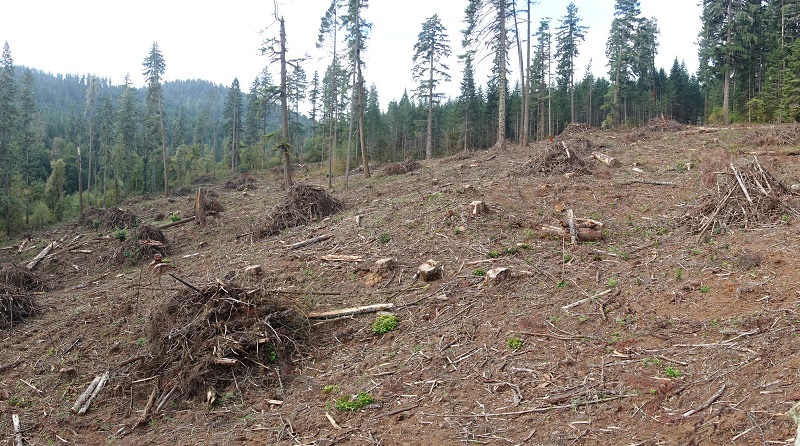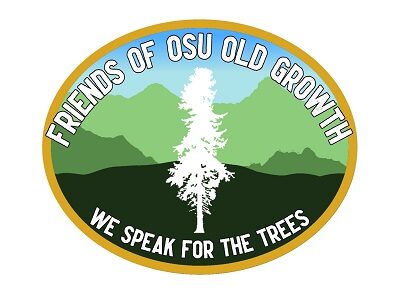When the public learned that Oregon State University’s College of Forestry had cut 16 acres of ancient forest in May of 2019, interim dean Anthony Davis characterized it as a “mistake”. In his letter of July 12th, 2019, he wrote:
“While operating with the best of intentions and within the guidance of the 2005 Forest Plan, we made a mistake in carrying out this recent harvest.” (1)
While some saw this as a rare admission of wrongdoing by a leader of the College, others took offense at his choice of words. A mistake implies that cutting the trees was, “an action, decision, or judgment that produced an unwanted or unintentional result” (2). Did the men in charge, both veteran foresters, not realize what they were doing when they marked the giant trees to be cut? Was the Interim Dean completely unaware they would be cutting centuries-old trees – or did his staff fail to properly inform him? With the planning process for this cut taking nearly two years, it must have taken a long series of mistakes for the ancient forest to be cut.
Experienced observers also questioned the Interim’s Dean’s insistence that they were, “operating with the best of intentions and within the guidance of the 2005 Forest Plan“. The College earned roughly $460,000 from the cut, nearly 1/3 of the Research Forests’ annual operating budget (3). The official reason for harvest was “revenue generation”. The small harvest size and high return lead one to conclude making money was a big part of their “best intentions”. Under the College’s 2005 management plan for the McDonald Forest, this stand was recognized as habitat for threatened northern spotted owls – and should have been protected. The fact that northern spotted owls had actually nested in the adjacent section of old growth should have been common knowledge among the Research Forest staff. How does the interim dean reconcile this disconnect between his words and the evidence?
Unfortunately, the letter from the Interim Dean was only part of a larger pattern of misinformation. The College’s Forest Manager, Brent Klumph, initially told a neighbor that they, “absolutely didn’t cut any old growth” and suggested the stumps we’d seen were relics from the past. In email messages and documents, the Forest Manager, Director, and Interim Dean all insisted cutting the stand was justified due to signs of mortality – even though aerial photos show few dead crowns, and the College’s own timber cruise found only ~4% diseased or dying trees (a healthier-than-normal stand).
All this (and more) background information makes it clear Research Forest staff knew precisely what they were doing when they decided to cut this ancient forest. To suggest it was a mistake – that the result was, “unwanted or unintentional”, ignores the basic facts and context of the situation. The fact that the Research Forest Director and members of OSU’s Elliott team continued to deny it was a mistake months after the Dean’s pronouncement to the contrary, further eroded public trust. Words matter, especially when spoken by those in charge of our public institutions.
The timber industry and their partners cloak the ugly destruction of their modus operandi in euphemisms. You will rarely read or hear the word “clearcut” from them except in discussions about negative public perceptions. Forest managers talk of “reprod” or “regen” (reproduction or regeneration) cuts – an oxymoron that avoids any thought of ecological consequences by focusing on the planting of the next crop. Like the visual corridors of trees left standing along highways, the language helps to hide the ugly impact of industrial forestry.
Folks with forestry degrees (whether they be at OSU, in government agencies, or private timber companies) use the term “harvest” as if they are simply cutting corn or cabbages. That frames the act squarely in terms of timber production and economics. It also creates a barrier to even having a discussion about the ecological impacts. To folks who see mycorrhizal connections between trees and soil as the foundation of forest life, who feel connected to trees and maybe even view them as sentient beings, the term “harvest” can be highly offensive. Crops are harvested from fields to feed us, and organs are harvested from cadavers to give new life. But destroying an entire community of inter-connected, living species, one that evolved without the hand of man…is that harvest or plunder, forest management or ecocide?
The Interim Dean of the College of Forestry, Anthony Davis, clearly understands the power of words when it comes to shaping public perception. At the Land Board meeting in early December, he once again spoke of forestry being “the intersection of climate change and sustainability” – despite the egregious failures of his staff to follow their own forest plan, protect old growth and northern spotted owl habitat, and prioritize carbon storage of the forests. He speaks of his love for trees and frequently quotes Aldo Leopold. What seems to be missing is honest introspection – an understanding or acknowledgement that many of the College’s forestry practices are squarely at odds with what Leopold stood for. Perhaps next time he addresses the Land Board, he should read this quote from Aldo Leopold:
“In my own field, forestry, group A is quite content to grow trees like cabbages, with cellulose as the basic forest commodity. It feels no inhibition against violence; its ideology is agronomic. Group B, on the other hand, sees forestry as fundamentally different from agronomy because it employs natural species, and manages a natural environment rather than creating an artificial one. Group B prefers natural reproduction on principle. It worries on biotic as well as economic grounds about the loss of species … [and] a whole series of secondary forest functions: wildlife, recreation, watersheds, wilderness areas. To my mind, Group B feels the stirrings of an ecological conscience.” (4)
During a tour of OSU’s ‘No Vacancy’ site (where the old-growth was cut), one person took great exception to describing it as a “clearcut”. He pointed to the dozen or so large “wildlife” trees left standing, claiming it was clearly a, “harvest with retention”, consistent with the purpose of the (research) forest. His choice of timber-industry jargon seemed curious given that he served as our (sole) public representative on OSU’s forest planning committees in 1993, 2005, and 2019. His vehement rejection of the term “clearcut” makes me question whether he has truly been serving the public’s interest on the forest planning committees.

Linguistic barriers also dominate the academic world, injecting a predictable undercurrent of bias and a barrier to understanding. OSU’s plan for the Elliott State Forest uses terms like, “extensive retention” and “intensive regen” rather than clear, commonsense descriptions like, “50% thinning” and “clearcut”. Even progressive forestry textbooks often follow this same pattern: “The most productive arena for creating silvicultural systems that effectively integrate ecological, economic, and cultural objectives is application of silvicultural practices in the central range of the retention/removal continuum“. This kind of language is a complete turn-off for people who tend to be creative, intuitive, and spiritual thinkers. The end result is an educational system that screens out the very people we need to bring into forestry in the 21st century.
These are not simply issues of semantics or academics, but the fundamental language and lens used to understand and define the field of forestry and its role in society. When the entire “academic/governmental/industrial forestry complex” speaks in technical jargon and euphemisms, it excludes the public and taints everything they do. The use of this esoteric, cumbersome, and even deceptive language also splits us into “insiders” and “outsiders”. Until forestry folks learn to speak in a clear and honest manner, they will continue to lose public trust.
(1) OSU College of Forestry, “Forest Update”, 7-12-2019, interim dean Anthony Davis, https://friendsofosuoldgrowth.org/wp-content/uploads/2019/07/Forest-Update-7-12-2019.pdf
(2) Merriam-Webster dictionary
(3) ‘No Vacancy Harvest Q and A Fact Sheet’, June 25 & 27th, 2019, Brent Klumph, Forest Manager
(4) A Sand County Almanac & Other Writings on Ecology and Conservation, Aldo Leopold, 1949
